This page is a current work in progress, please bear with me.
I differentiate presidential medals into two categories. What you will primarily find on this page are presidential medals that were manufactured and presented during a president’s term in office. The other type of medals are those which often mimic presidential Medals. Many of these are parts of medal sets manufactured for collectors, very similar to the Franklin Mint Sets.1 Here are some examples of what I refer to as Collector Medals as opposed to Presidential Medals.
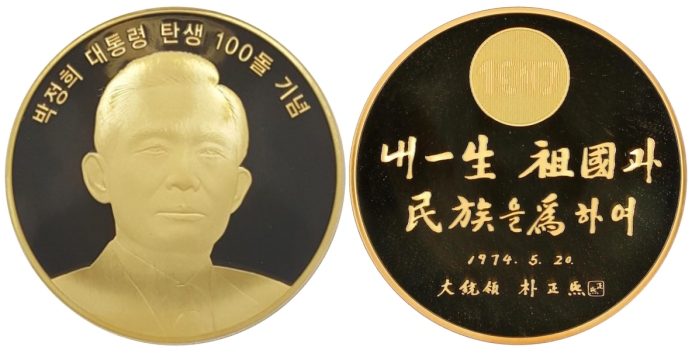
This is a 1 oz (31.1 g)., 99.9% gold collector’s medal, honoring the 100th Birthday of President Park Chung-hee. Manufactured in 2017 by the Korea Minting and Security Management Corporation (KOMSCO). Issue quantity was 50, but two of them were given to the Park Chung-hee Museum.
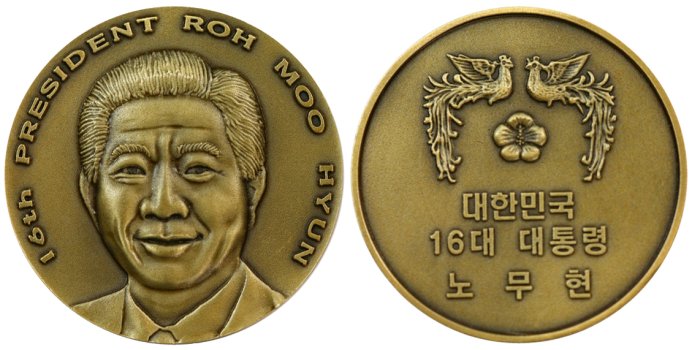
Medal from a medal collector set
Presidential Medals
Park Chung-hee
Park Chung-hee 박정희 (朴正熙 1917-1979) was the President of South Korea from 1961 until his assassination in 1979. He came to power after leading a military coup in 1961. Initially ruling as an unelected military junta strongman from 1961 to 1963, and later as the elected third President of South Korea from 1963 to 1979.
During his tenure in office, Park began a series of economic reforms and building projects that eventually led to rapid economic growth and industrialization. South Korea became one of the world’s fastest growing economies during the 1960s and 1970s. Considerable work was done in collaboration with state supported, enormously wealthy, family-owned companies called chaebols. Similar to the Japanese zaibatsu.
Although popular during the 1960s, Park’s popularity peaked in the 1970s, and as that decade progressed his rule became more and more autocratic and dictatorial. In 1972, Park declared martial law and introduced the Yushin Constitution. This gave him the legal means to ruthlessly suppress political opposition and dissent. The constitution also gave him complete control of the military, and considerably control over the media and expressions of art.2 In 1979, Park was assassinated by Kim Jae-gyu 김재규 (金載圭 1924 – 1980), director of the Korean CIA (KCIA). Even with his death, the economy continued to grow due to the mechanism he had put in place, but the country was rocked by another military coup in 1979 and was unable to fully democratize until 1987.
He is generally regarded as an authoritarian dictator who prioritized economic growth at the expense of civil liberties and human rights. He remains a controversial figure in South Korea.
Park’s eldest daughter Park Geun-hye 박근혜 (朴槿惠 1952- ) would later serve as the 11th president of South Korea from 2013 to 2017, when she was impeached and convicted of corruption. She is the country’s first female president, and its first democratically elected leader to be thrown out of office. She was pardoned on Dec. 24, 2021.
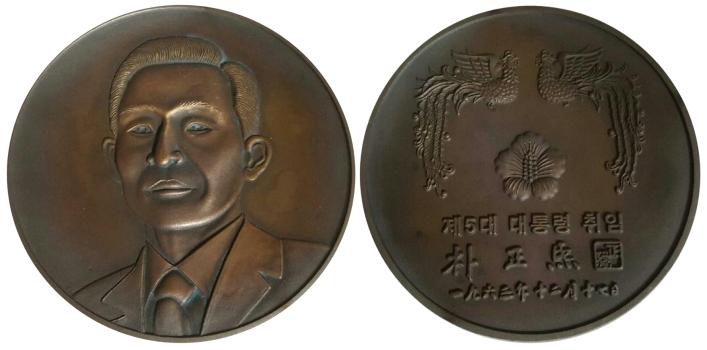
The top-line inscription is 체5대 대통령 취임 ‘Inauguration of the 5th president’. The second line is 朴正熙 ‘Park Chung-hee’ in Chinese characters. This is followed by his personal name stamp 인장 (印章). On the bottom line, also in Chinese characters, is the date 一九六三年 十二月 十七日 Dec. 17, 1963
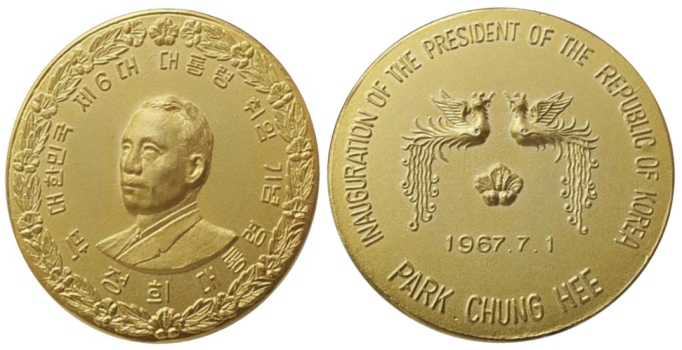
The inscription around the top is 대한민국 제6대 대통령 취임 기념 ‘Commemoration of the Inauguration of the 6th President of the Republic of Korea’. At the bottom is the inscription 박정희 대통령 President Park Chung-hee. The medal has a 64 mm diameter, a 4 mm thickness, weighs 150 g. and is gold-plated bronze.

On the obverse is the inscription 대한민국 “Republic of Korea”, below which is 제7대 대통령 취임 기념 “Commemoration of the inauguration of the 7th President” and at the bottom is 박정희 대통령 “Park Chung-hee President”. The reverse in completely in English, “inauguration of H.E. Park Chung Hee • 7th President of the Republic of Korea, July 1, 1971”.
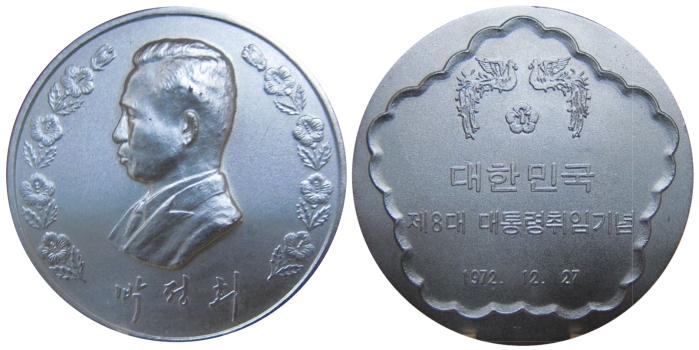
On the obverse is the signature of Park Chung-hee. The top line on the reverse is 대한민국 “Republic of Korea”. Followed by 제8대 대통령 취임 기념 “Commemoration of the inauguration of the 8th President”, and at the bottom is the date “1972.12.27”.
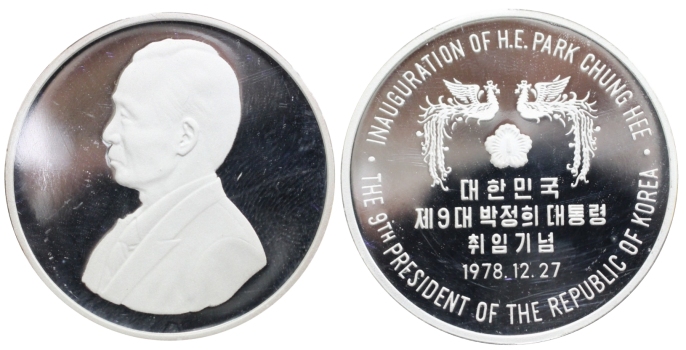
The English inscription is ‘Inauguration of H.E. Park Chung Hee, The 9th President of the Republic of Korea’. The Korean inscription in the center, is 대한민국 ‘Republic of Korea’ 제9대 박정희 대통령 ‘9th President Park Chung-hee’ 취임기녀 ‘Inaugural Commemorative’ and lastly, the date 1978.12.27.
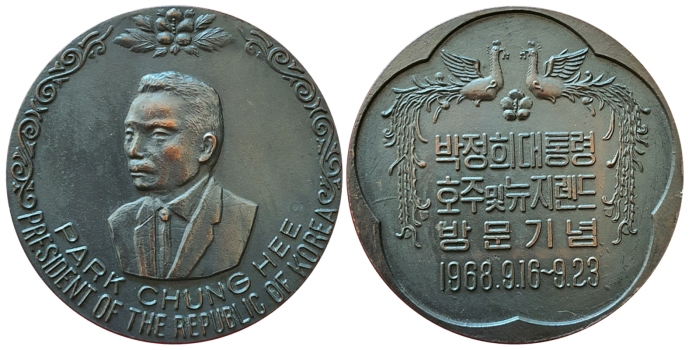
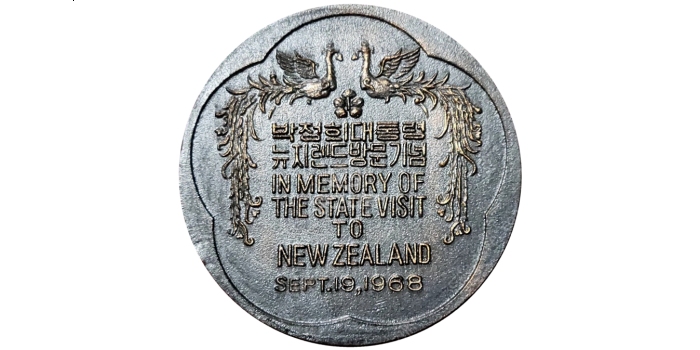
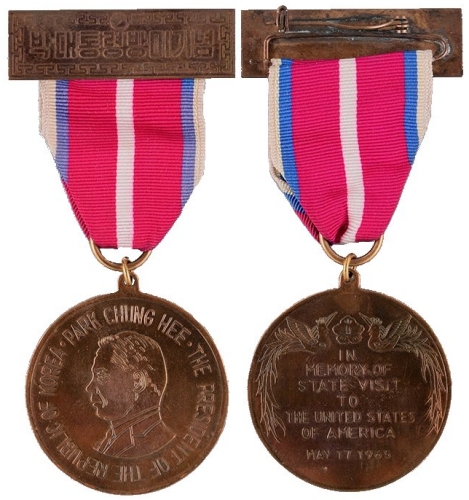
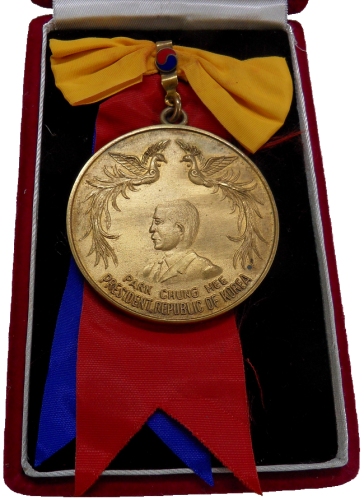
Chun Doo-hwan
Chun Doo-hwan 전두환 (全斗煥 1931 – 2021) was a South Korean army general3 and military dictator who ruled as an unelected president from 1979 to 1980 and then as a self-elected president from 1980 to 1988. He usurped power after the 1979 assassination of president Park Chung-hee. Chun orchestrated the Dec. 12, 1979 military coup, then cemented his military dictatorship in another military coup on May 17, 1980. After which, he declared martial law and replaced Choi Kyu-hah 최규하 (崔圭夏 1919-2006), the legal president of South Korea.4 In 1996, Chun was sentenced to death for numerous offenses and for his role in the Kwangju Massacre, which had led to the deaths of thousands of citizens. His sentence was changed to life in prison, but was commuted the following year, by President Kim Young-sam 김영삼 (金泳三 1927-2015) on the advice of the incoming President-elect Kim Dae-jung 김대중 (金大中 1924-2009).5 Chun was fined $203 million, the amount of money that he had embezzled through corruption during his regime and that of his successor Roh Tae-woo 노태우 (盧泰愚). This fine was mostly never paid. In March 2006, he was stripped of his national honors and medals. In his final years, Chun was criticized for his unapologetic stance and the lack of remorse for his actions in the Kwangju Massacre and as the leader of a dictatorial regime.
There are four representative medals for Chun Doo-hwan. They are:
- A medal for the National Saemaul Leadership Conference,
- A medal for the Peace and Unification Policy Advisory Committee,
- A medal for President Chun Doo-hwan, and,
- A medal to commend the hard work of the members of the Social Cleanup Committee.
Medal for the National Saemaul Leadership Conference
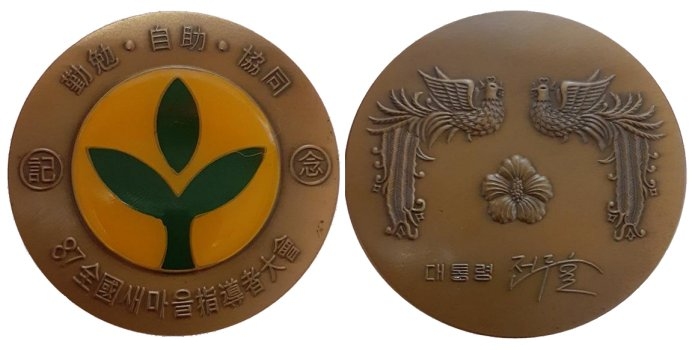
On the obverse, all the characters used are Chinese, except for the word ‘Saemaul’. At the top is 勤勉 自助 協同 (근면 자조 협동) ‘Diligence, Self-help, Cooperation’. The two characters to the right and left, in circles, are 記念 (기념) ‘To Commemorate’. At the bottom is 87 全國새마을指導者大會, ‘1987 National Saemaul Leadership Conference’. At the center is the symbol of the Saemaul Movement. The yellow circle represents cooperation, wealth and limitless possibilities. The green leaves / buds represent Diligence, Self-help, and Cooperation. The wide base of the stem signifies stability and prosperity.
On the reverse is the symbol of the Korean President and the inscriptions: 대통령 ‘President’ and 전두환, the signature of Chun Doo-hwan.
The Medal is 6 cm across, but I have no information on thickness or weight.
The Saemaul Movement is a government sponsored program to develop the infrastructure of Korea from the bottom up. Under President Park Chung-hee 박정희 (朴正熙 1917-1979), two ‘Five Year Economic Development Plans’ (1962-66 & 1967-71) had emphasized industrial and export development, with economic development policies ignoring the needs of the rural communities. A major side effect was that agriculture lagged far behind the industrial sector, with the average farmer earning about 50% of what urban laborers were being paid. This resulted in a rapid shift of rural populations into the large industrial centers. Before the 1971 Presidential election, rural communities had supported the ruling party of President Park Chung-hee; but as living conditions deteriorated for rural residents, they turned their backs on the ruling party. Saemaul Undong 새마을운동 (New Village Movement or New Development Movement) was created as a part of the third ‘Five Year Economic Development Plan’ to bolster agriculture. It was proposed in 1970 and launched on April 22, 1970. Its stated goal was to modernize the rural economy. President Park Chung-hee in a special declaration on Oct. 17, 1972, announced that the Saemaul Movement was to be given top priority in National Policies. By 1973, it had become a nationwide movement. The early campaigns focused on improving the living conditions of rural environments, while later projects were more focused on improving the rural infrastructure. As part of the government’s revitalizing efforts, the regime reviewed its Orders and Merit Medals, and in January 1973, it created the Order of Saemaul Service Merit, in 5 classes and a Saemaul Service Merit Medal. The first Presidential cash awards were also given out in 1973.
The Saemaul Undong Project does have its detractors. Foremost is the fact that each village is coerced into competing with other villages for the scarce material resources that the government offers. This is in direct opposition to the traditional mutual aid societies (Kye 계) that are commonly found in rural villages. The second major complaint centered on the leaders of the movement, especially at the village level. There is ample opportunity for personal gain at the expense of the villagers. The Orders, Medals, and Commendations used to reward the movement’s leaders could also be used to enhance their careers, especially if they decide to find more advantageous employment in the cities. The Saemaul Undong Project has been a tremendous success. It now includes the urban areas of the country, and has been copied in several other countries. It was a highly successful project during the 1970s, but lost most of its momentum with the death of President Park Chung Hee.
Saemaul Undong 새마을운동 is such a unique Korean institution that the name ‘Saemaul’ is never written in Chinese Characters. When Chinese characters are used, they are only used for other words, like ‘Movement’, as in 새마을 運動, ‘Saemaul Movement’. You will see this in the caption of the medal to your right.
Two interesting little side-notes. While the movement started as a top-down program instituted by a dictatorial regime, in many ways, it let to a bottom-up democracy movement. Moreover, this medal, nor this leadership event, is mentioned on the Official Saemaul Website.
Commendation medal for the Social Purification Committee
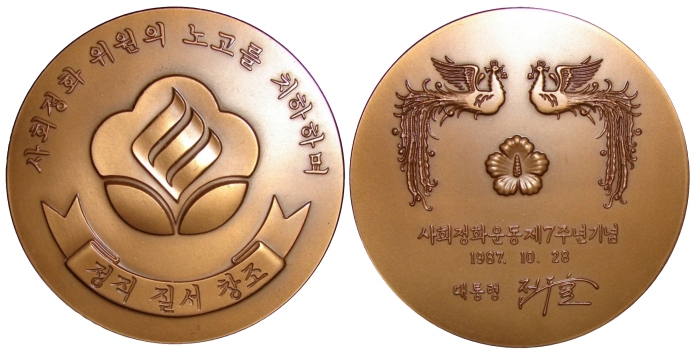
This was an official medal given to the committee members, for their hard work on the 7th Anniversary (1987) of the Social Purification Movement.
The stated aim of the Social Purification Committee was the elimination of social ills, such as violence, smuggling, illegal drugs, and deceptions. However, the committee was a disaster for the media and for popular culture media, including cartoons. To solidify the regime of Chun Doo-hwan and to suppress opposition, he created and mobilized an organization called the Committee for Social Purification. This organization created the Samchung Re-education Camp 삼청교육대 (三清教育隊) which was a South Korean concentration camp. Here some 60,000 to 100,00 people, many of them being innocent civilians with clean criminal records, were arrested without warrants and faced violent treatment in their re-education. It was a prison camp for critics of the new military regime and people considered to be a “social ill.” This included surviving participants of the Kwangju Uprising, better known as the Kwangju Massacre. Within a span of six months of its opening in August 1980, more than 40,000 people were incarcerated. Many of whom had clean criminal records. Once in the camp, they were forced into hard labor or faced physical violence by the military. The camp had 4 classifications for the inmates, namely: A, B, C and D (가, 나,다 & 라). Each letter corresponded to the severity of treatment an interned person would receive in the camp. With A being the most severe and D the least. The number of people who died in the camp due to the severity of their injuries is unknown, but it is believed to be at least 339.
The obverse inscription is 사회정화 위원의 노고를 치하하며 ‘Appreciating the hard work of the Social Purification Committee’. At the bottom is a banner with the inscription 겅직 질서 창조 ‘Honesty creates order’, which was the official slogan of the committee. The reverse inscription is 사회정화운동제7주년기장 ‘The 7th Anniversary of the Social Purification Movement’, followed by the date, 1987.10.28, and at the bottom 대통령 ‘President’ and 전두환, the signature of ‘Chun Doo-hwan’. The medal has a 60 mm diameter, a 5 mm thickness and weighs 122 g. The medal came in a fitted case. I found one reference which claims that this medal has been designated as Cultural Property No. 649.
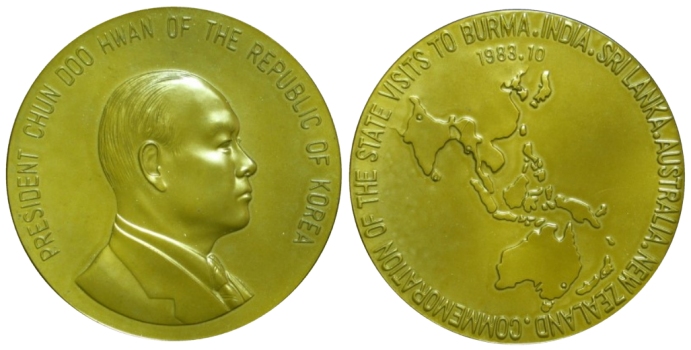
Both the obverse and reverse are in English. On the obverse is the inscription “President Chun Doo Hwan of the Republic of Korea”. On the reverse is the inscription “Commemoration of the State Visits to Burma • India • Sri Lanka • Australia • New Zealand”. There is a small inscription above the map that is the date “1983.10”
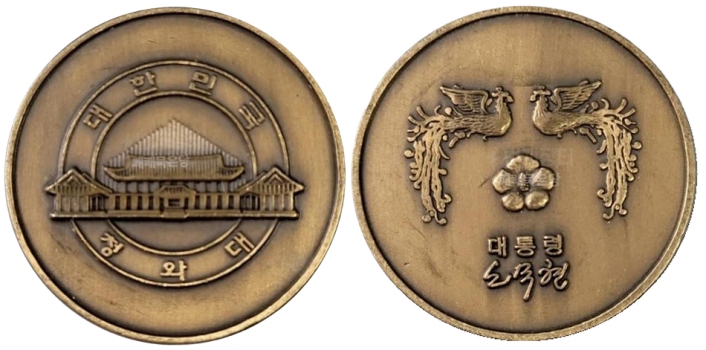
Roh Moo-hyun
President Roh Moo-hyun 노무현 (盧武鉉 1946-2009) was a member of the ‘386 Generation’ 세대 (386 世代) which comprises those South Koreans, born in the 1960s and attended college in the 1980s. They were the first generation not born into poverty. The name is derived from the Intel 386 Computer. In general, they were active politically as young adults and were instrumental in the Democracy Movements in the 1980s. Roh’s political career was focused on human rights advocacy for student activists and eventually expanded to overcoming regionalism in South Korean politics. It was the 386 generation that got him elected. Members of the 386 generation now comprise much of the elite in South Korean society.
This medal was given during the presidency of Roh Moo-hyun as a token to commemorate a person’s visit to the Blue House. The Korean equivalent of the U.S. White House. Traditionally, houses with blue tile roofs indicated high social status for the family living there. Today, it is the most popular roof color in Korea (everyone wants to be an aristocrat).
On the obverse there are two inscriptions. At the top is 대한민국 ‘Republic of Korea’ and at the bottom is 청와대 ‘Blue House’. On the reverse, there is 대통령 ‘President’ and 노무현, the signature of Roh Moo-hyun.
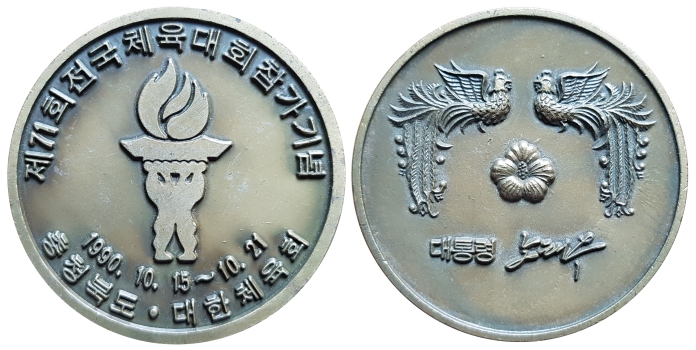
The top inscription on the obverse is 제71회 전국체육대회참가 기념 ‘Commemoration of participating in the 71st National Sports Festival’. At the bottom, the upper inscription is the dates of the Sports Festival 1990.10.15 – 10.21. The lower inscription is 충청북도 • 대한체육회 ‘Chung-cheong Buk Do’ which is the province where the event was held, followed by ‘Korea Sports Association’.
On the reverse is 대통령 ‘President’, followed by 노태우 the signature of Roh Tae-woo.
Footnotes:
- The Franklin Mint sells coins, medals, jewelry, die-cast vehicles, dolls, sculptures, plates, knives, LP record sets, die-cast vehicles, coffee cups, hats, shirts and other collectibles.
- As an example, KBS TV was under KCIA jurisdiction.
- Chun Doo-hwan was a Vietnam Veteran, having served with the ROK forces in Vietnam from 1970-71.
- After the assassination of Park Chung-hee in 1979, Choi became acting president. Article 48 of the Yushin Constitution places the prime minister as next succeeding president, should the president be unable to continue the duties of his office.
- Chun’s administration had sentenced Kim Dae-jung to death some 20 years earlier.
